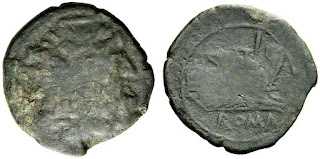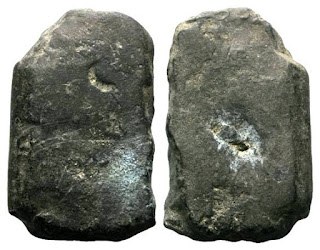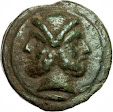A Small Janus Head and Prow Right Bronze Coin
RR As?; Cr 97, 99, 100… Something Else?
When
I buy a coin on line, I take the seller’s pictures to record the piece in my
collection. This coin from Numismatica Tintinna’s e-Auction 70 is not easy for
me to attribute. I used Google Translate to convert Italian to English, did a bit of reading and wrote the description that follows. My best guess is the coin is a Cr 100/1b, or something close. The coin is low weight (3.37 grams), has a distinctive Janus head, a different (close to 90 degree) angle for the right facing prow and visible sprews on opposite sides. The coin has a well worn reverse, but it looks like ROMA was spelled backwards and the A is on the left side. I will show some Cr 100's first and then other bronze coins that look a bit like my coin. Comments from others would be appreciated.
Repubblica
Romana - 206-195 a.C. Asse anonimo di peso ridotto. Canosa?. D/ Testa di Giano.
R/ Prora nave. Peso 3,37 gr. Diametro 18,6 mm. BB/qBB. Patina verde. R.
Roman
Republic - 206-195 BC.
Anonymous
As of reduced weight.
Mint
- Canosa ?
Obv
- Head of Janus
Rev
– Prow of Roman war ship right, letter below left end of prow could be R or A,
I think it looks like A.
Weight
3.37 gr.
Size:
17.2 mm, sprew to sprew; 18.5 mm dia. & 2.0 mm thick
Condition:
·
Obv
– VF
·
Rev
– aG
·
Brown
patina (I am slightly color blind so might not see the green Massamo mentions.)
·
Strike
- weak strike due to thin flan
·
Flan
flaws - casting sprews visable, thin flan due to low weight
·
Style
- good style on obv, but mint mark, if any, is missing
·
Damage
- reverse design mostly missing due to corrosion or cleaning
·
Centering
– good, but small size / low weight may have forced some features off flan
Cr
100/1b (if Canusa is correct), R
BMCRR
Italy 265 (31 grams)
Numismatica
Tintinna - eAuct 70; Lot 116; 2/20/2018
Some observations of this coin:
bronze
coin
1. low weight, 3.37 grams
2. thin flan, dia = 18.6 mm
3. casting sprews are visible at 12 and 6
Janus head obv
1. short neck
1. low weight, 3.37 grams
2. thin flan, dia = 18.6 mm
3. casting sprews are visible at 12 and 6
Janus head obv
1. short neck
2. two
faces are almost square
3. flat
arc below neck, probably not mark of value....
4. beard
and hair are curly, like cotton bolls
5. might
have CA over heads, but could be my imagination!
6. Thin
flan, part of faces are level with field
Reverse
1. Prow Right, prow is at a 95o angle to the water in front of the ship. Note most RR coins have a smaller angle.
1. Prow Right, prow is at a 95o angle to the water in front of the ship. Note most RR coins have a smaller angle.
2. Mark
of value, I, above.
3. in
ex – The letter A is on left side of coin. I do not see other letters. There
are some dots where the tops of letters should be found. There are a few
examples of RR bronze coins and imitative RR bronze coins with ROMA reversed.
Attribution
–
It
is hard to find a match for this coin in most of my books on Roman Republican
coins. The vendor suggested Canosa (Canusium). This looks like a good choice,
but Crawford’s weight standard is 27 g with an average 23 g for 13 know coins
at the time the book was published in 1974. Crawford 97 and 99 have similar
designs and Cr 97 has a low weight example, 7 g. The coin is missing the
letters CA that are on Crawford 100/1a, 1b or 1c. Crawford notes these bronze
coins are not common.
I
found 27 examples of Cr 100/1 on line and in books. Some did not have CA for
positive ID. The coins ranged 1.7 grams to 25.4 grams. Most of the coins are
near the weight listed by Crawford. The light weight examples do not have the
letters CA.
R
Witschonke wrote about RR coins not in Crawford: Some Unpublished Roman
Republican Coins in Essays in Honour of Roberto Russo in 2013. He shows two
“full sized” coins from Canusium (one without CA on the reverse and one without
CA on the obverse and reverse). A reduced size, 6.48 gram, coin without CA on
the obverse or reverse was also shown. These coins were sold as part of the RBW
Collection (rbw 1 - 5) . Since then several coins of less than 10
grams have been offered in auctions. Some of the low weight asses are late
Republican issues. See the coins of D. Junius L.f. Silanus, Cr 337/5, 91 BC;
below. Most of the low weight asses have been attributed to Canusium: Cr 98, L;
Cr 99, P and Cr 100, CA. Most of these low weight coins do not have the letters
L, P or CA.
Cr-100/1_, CA examples. Of the 5 RBW coins, only #5 is close on weight.
Crawford 97/28, as
The ANS museum on line has a Cr 97/28 that weighs 1.95 g, but no pic.
Crawford 97/?; uncia & sextans; these coins have similar right facing prows
Crawford 99
SICILY, Panormos. Roman protectorate. After 241
BC
CNG e199; 4.5 g;
note the Janus head, coin weight and visable sprews at 12 & 6 are similar to my coin.






















































